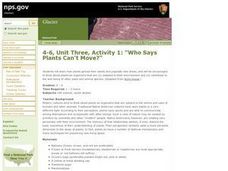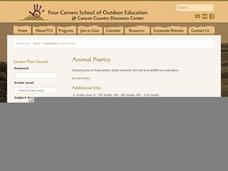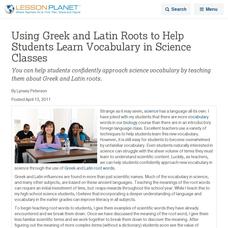NASA
Introduction to Astronomy
Welcome to your new job as an astrophysicist, astrobiologist, engineer, or research scientist at NASA. Your job is to search for alien life in our solar system! Throughout a unit of activities, learners search the galaxy through...
K20 LEARN
Periodic Shuffle: Introduction to Periodicity and Electron Configuration
No matter how you shuffle the elements, their electron configurations keep them in the same order. How can that be? Introduce the concept of periodicity through a lesson that combines inquiry, discussion, and comparison. Partners...
Howard Hughes Medical Institute
Recent Adaptations in Humans
You've probably spent plenty of time discussing animal adaptations with your young biologists, but what about human adaptations? Explore the evolving traits of humankind through an interactive that combines text and video clips. Scholars...
National Center for Case Study Teaching in Science
A Deadly Passion
Depending on the level of maturity of your class, the case study presented here could be fascinating. It focuses on the mating behavior and post-mating rituals of the Australian redback spider, which involves the female eating the male...
Curated OER
Who Says Plants Can't Move?
Students discover how plants spread their seeds using other plants and animals. In this plant instructional activity, students role play different plants and how their seeds travel. Students then have a class discussion to ensure their...
Curated OER
Basic Needs of Living Things - Lesson One
An interesting way of teaching about basic needs of different organisms awaits your fourth graders. Pupils take part in class discussions and demonstrations which should lead to a greater understanding of how to determine basic needs. As...
Curated OER
Introduction to Density
Seventh graders discover the definition of density through a demonstration using ethanol and ice cubes and a class discussion using a SMART Board to illustrate formulas and calculations. Students finish the lesson by practicing...
Curated OER
Folic Acid Health Campaign
A prewriting prompt, a class discussion, a website visit and accompanying worksheet, and a culminating group project make up this lesson plan on public health awareness. The topic is folic acid and how its absence in the diet may...
Curated OER
Rocks and Minerals
Take young geologists on an exploration of the collection of rocks and minerals that we call Earth with an upper-elementary science instructional activity. Through a series of class discussion and hands-on investigations, students learn...
Curated OER
Animal Poetry
Fourth graders write poems that use local wildlife as their inspiration. After a class discussion which produces a list of wildlife that pupils have seen in their town, a review of three types of poetry ensues. They look at how haiku,...
Desert Discoveries
Lizard Dash!
Here is a terrific learning game that has pupils acting like lizards! Before the game starts, there is a class discussion on the differences between endotherms and exotherms. The main focus of the game is how each team must keep their...
Curated OER
More of, Less of
Have your class discuss behaviors they like from other people. They will then get into groups and list behaviors they want to see more of from people in their community, classroom, or school. This is a great Character Counts lesson!
Curated OER
Using Greek and Latin Roots to Help Students Learn Vocabulary in Science Classes
You can help students confidently approach science vocabulary by teaching them about Greek and Latin roots.
Curated OER
Science Fiction Fun
In this writing worksheet, students read a science fiction book and write a report. Students follow the 6 guidelines and answer the questions to complete this report.
Curated OER
Into the Fifties: Understanding the Context of Film Genres in the Fifties
Learners discuss prior knowledge of American culture during the 1950's. They complete KWL charts, participate in class discussions and view the documentary film Atomic Café. They record their observations from the film.
Curated OER
Kindergarteners Study the Four Seasons
Examine the weather of the four seasons, look at seasonal activities, and tell which months are part of each season with this lesson. Your class will play a game, sing a song, and write additional stanzas to seasonal poetry.
Carnegie Mellon University
Bathtub Model
Using a colorful infographic handout and a guide sheet, hold a class discussion about how a bathtub can serve as a model for the greenhouse effect created by Earth's atmosphere. Participants will understand that as energy or matter is...
Curated OER
Seasons Of Art
Students engage in a lesson that is about the study of seasons and the colors related to them. They use paints in order to create a window scene. Students engage in class discussion about the seasons of the year and make comparisons.
Curated OER
Nuclear Energy
Atomic theory as a philosophical study was explored even by the Ancient Greeks. The knowledge of atoms was developed in the 17th century. This PowerPoint explains how by the 1940's, splitting of the atom was discovered and since then,...
Curated OER
We're All Passenger
Students examine Passenger Pigeons and why they are now extinct. Through a class discussion, students discover the need to help endangered animals. They consider activities to become involved in assisting animals. Students write a poem...
Curated OER
To Tell The Truth
Students create a faux ivory napkin ring using art supplies and knowledge gained from in-class discussions and teacher supplied information in this art lesson easily adaptable to a Social Studies or Language Arts classroom.
National Nanotechnology Infrastructure Network
Introduction to Nanotechnology Using the Creative Problem-Solving Model
Should we continue to spend money on nanotechnology? Groups engage in a problem-solving unique process around the newly emerging research field of nanotechnology. In order to propose a solution, the groups must research nanotechnology...
EngageNY
End of Unit Assessment Part II: Science Talk
Scholars complete Part 2 of their end of unit assessment by having a science talk. Pupils pair up to answer questions about what makes a natural disaster. As one learner talks, the other records what is said. They then trade places.
Center for Learning in Action
Properties of Balls
Enhance your states of matter lessons with a hands-on science investigation that compares six different balls' color, texture, size, weight, ability to bounce, and buoyancy.

























